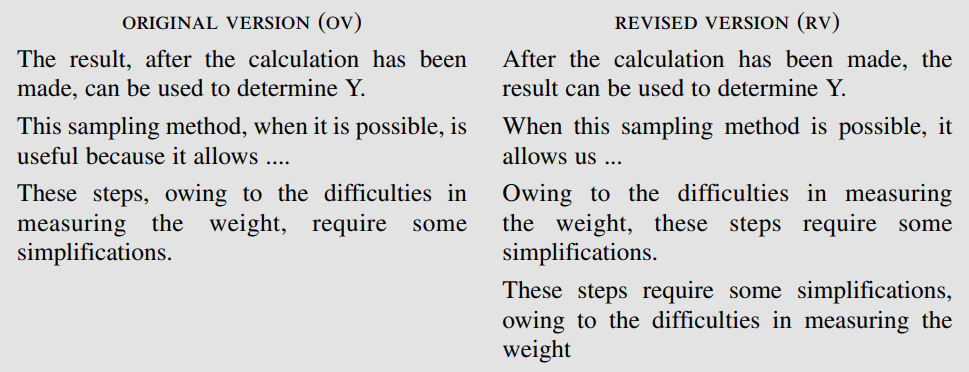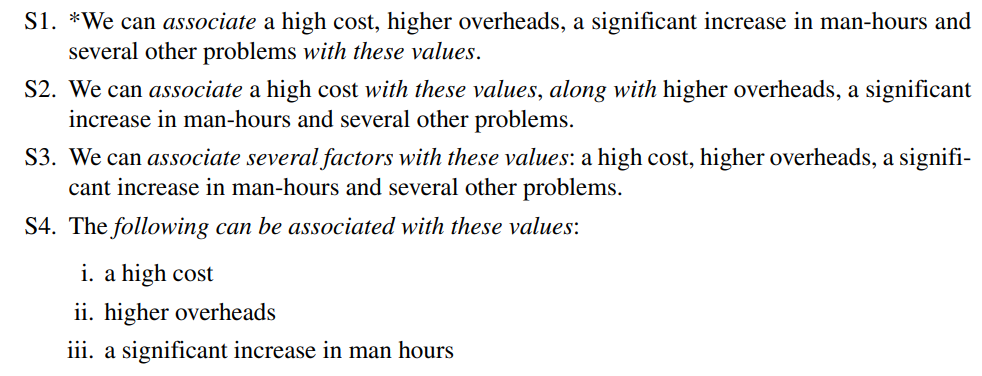from “English for Writing Research Papers”
加*的例句:错误的例子
If these parts come in a different order, this requires more effort by the native reader to understand the whole meaning
Basic word order in English: keep the subject, verb, direct object and indirect object as close to each other as possible
S1 shows an example of this order.S1. The researchers sent their manuscript to the journal.
This order is rarely altered. It is:
- subject (the researchers)
- verb (sent)
- direct object (their manuscript)
- indirect object (the journal)
The key is to keep the subject, verb, direct object and indirect object as close to each other as possible.S2(correct). Last week the researchers sent their manuscript to the journal for the second time.S3(wrong). The researchers last week sent for the second time to the journal their manuscript.
S3: The position of last week and for the second time is wrong, and the indirect object comes before the direct object.
Put the subject before the verb


Keep the subject and verb as close as possible to each other
wrong:


correct:
make the meaning / direction of the sentence immediately clear


Avoid inserting parenthetical information between the subject and the verb
Sentences are much easier to read if they flow logically from step to step, without any deviations

Don’t separate the verb from its direct object: place the direct object before the indirect object

sometimes the direct object is very long and consists of a series of items:

Put the direct object before the indirect object

Choose the subject that is the most relevant
Clear English requires that you put the subject at the beginning of the sentence, however you may have a choice of possible subjects. eg:
X was elicited by Y.
Y elicited X.
S1. Particularly interesting for researchers in physics is the new feature, named X, for calculating velocity.S2. Physics now has a new feature, named X, for calculating velocity.S3(maybe best). Velocity can now be calculated with a new feature, named X, which is particularly interesting for physicists.S4(maybe best). X is a new feature for calculating velocity. It is particularly interesting for physicists.
choose the subject that will give the shortest sentence
S1. The most significant values are highlighted in Table 1.S2(choose this). Table 1 highlights the most significant values.
Shorter sentences are often obtained by using active (S2) rather than passive (S1)
verbs
Don’t make the impersonal it the subject of the sentence
Putting it first often delays the subject
wrong eg: It is probable that this is due to poor performance
Don’t use a pronoun (it, they) before you introduce the noun (i.e. the subject of the sentence) that the pronoun refers to
It is OK to use a pronoun at the beginning of the sentence, provided that this pronoun
refers back to a noun in a previous sentence (i.e. a backward reference). For example:S1. Beeswax is a very important substance because ... In fact, it is ...
In S1 it is clear that it refers to beeswax.
But in S2 it refers to a noun that comes after (i.e. a forward reference). The reader does not know what the pronoun refers to and thus has to wait to find out.S2. *Although it is a very stable and chemically inert material, studies have verified that the composition of beeswax is …S3. Although beeswax is a very stable and chemically inert material, studies have verified that its composition is …
Where to put adverbs of consequence and addition
Your aim is to try to put the subject at the beginning of the sentence. So if possible try to delay adverbs that indicate a consequence or add further support to a positive situation.
Thus S1 and S2 below would normally be better rewritten as S3 and S4.

Put adjectives before the noun they describe, or use a relative clause


Do not insert an adjective between two nouns or before the wrong noun
S1. *The editor main interface
S2. *The algorithm computational complexity
S3. The main interface of the editor
S4. The computational complexity of the algorithm
S5. *The main document contribution
S6. The main contribution of the document
Avoid creating strings of nouns that describe other nouns
you cannot say art state technology (state-of-the-art technology) or mass destruction weapons (weapons of mass destruction).
But you can say a software program or an aluminum tube
Native speakers do tend to string nouns together, but they intuitively know how to do it.
recommend that you verify on Google Scholar that your proposed string of nouns already exists and has been used by native English-speaking authors
Ensure there is no ambiguity in the order of the words
Ambiguity arises when a phrase can be interpreted in more than one way.
- S1. *Professors like annoying students.
In S1 it is not clear if ‘annoying’ describes the students, or it refers to what professors enjoy doing. Depending on the meaning, S1 could be disambiguated as in S3 or S4:
S3. Professors like to annoy their students.
S4. Professors like students who are annoying.
- S2. *I spoke to the professor with a microphone.
In S2 – did I use the microphone or was the professor holding it? Depending on the meaning, S2 could be disambiguated as in S5 or S6:
S5. Using a microphone, I spoke to the professor.
S6. I spoke to the professor who was holding a microphone.
- S7. *To obtain red colors, insects and plant roots were used by indigenous people.
In S7 readers may initially think that red colors and insects are part of the same list. Readers will only understand that insects and plant roots is the subject of the verb when they get to the end of the sentence.
To avoid this problem there are two possible solutions. S8 puts insects and plant roots as the main subject and S9 primitive people.
S8. Insect and plant roots were used to obtain red colors.
S9. To obtain red colors, primitive people used insects and plant roots
- S10. *The European Union (EU) adopted various measures to combat these phenomena. This resulted in smog and pollution levels reduction.
We tend to read words in small groups. Often we think that if two or three words immediately follow each other they must be related in some way.
When we read resulted in smog and pollution, our initial interpretation is that the smog and pollution are the result of the EU’s measures. Then when we move on and read levels we have to reprocess the information
S11. The European Union adopted various measures to combat this phenomena. This resulted in a reduction in smog and pollution [levels]
- S12. *We also demonstrated that x does not equal y as suggested by Walker (2011).
Does S12 mean that Walker suggested that x is equal to y and is thus in contrast to what you are saying (S13 and S14), or that he, like you, found that x does not equal y (S15).
S13. Unlike what was suggested by Walker (2011), we demonstrated that x does not equal y.
S14. Our findings do not concur with Walker (2011). In fact, we demonstrated that x does not equal y.
S15. In agreement with Walker (2011), we demonstrated that x does not equal y



